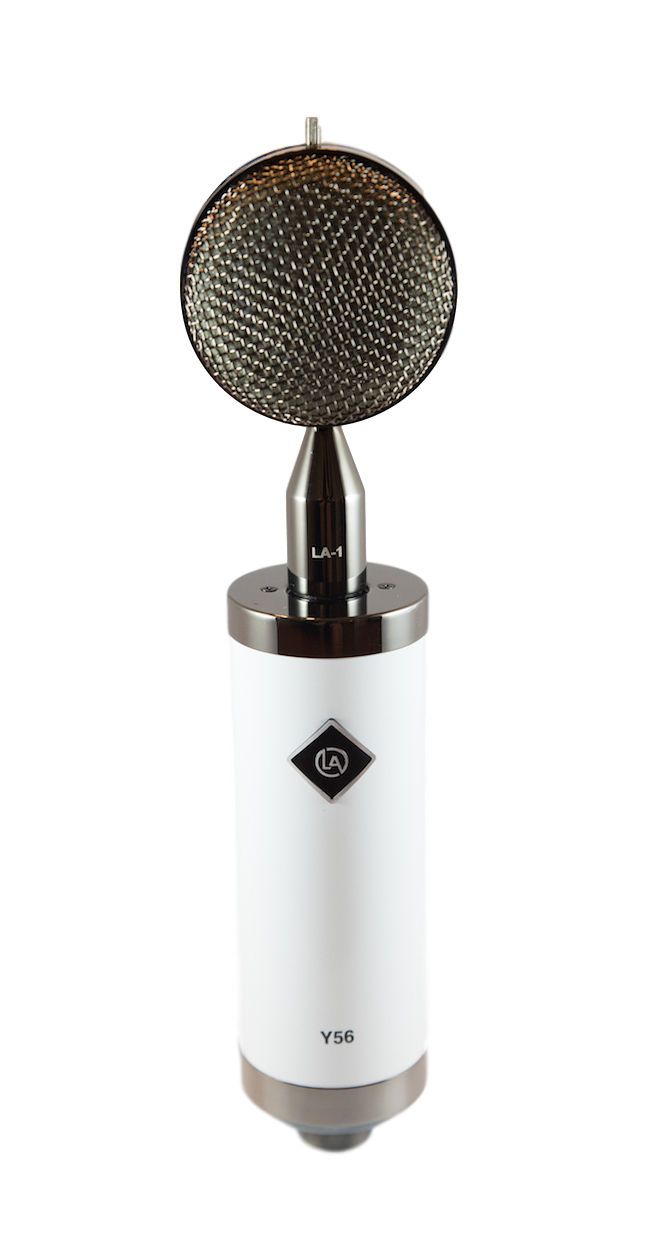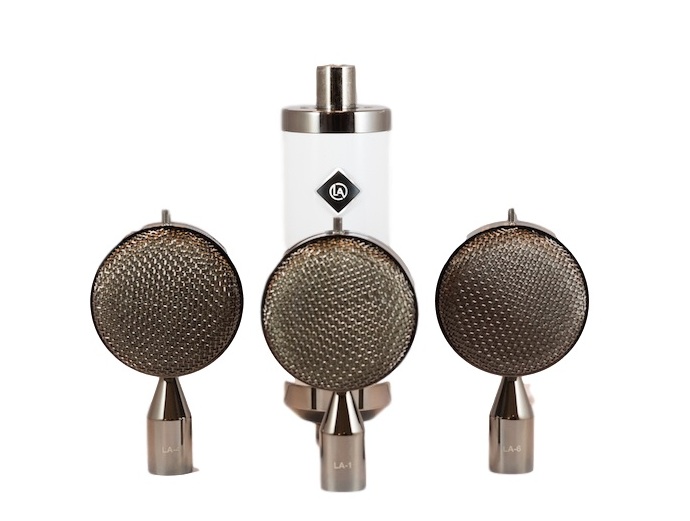New Gear Review: Luke Audio AL-Y56 Large Diaphragm Tube Condenser

Because of its interchangeable capsules, the AL-Y56 from Luke Audio offers the distinct tonalities of not one, not two, but three different microphones.
One of the most exciting aspects of the recording industry over the past decade is the emergence of talented designers and engineers founding new boutique audio companies.
Never before have we seen this many different manufactures providing such a wealth of choice to their customers. Many of these new companies have been able to leverage their online presence and lower operational costs to keep their price points lower, which has led to an explosion in the pro and “pro-sumer” markets.
In this vein, Luke Audio came onto the scene in 2016 with their acclaimed AL-X Series microphones, and this year they aim to step up their game even further with the new AL-Y56.
Features
The AL-Y56 is a large diaphragm, tube, pop-top microphone that comes with three very distinctly-voiced capsules. A pop-top microphone, if you didn’t know, has capsules which can be removed from the body of the mic. The capsules are hot-swappable, though you should mute the signal to headphones or speakers when switching just to be safe.
The mic is powered by a NOS 6072a vacuum tube with an 11.5:1 output transformer and features a 10dB pad located inside the mic. Luke Audio is also planning to release more capsules in the future that offer different polar patterns and “voicings.” The AL-Y56’s capsules, labeled A1, A2, and A3, are modified versions of the capsules found on the AL-X series microphones.
The build quality of the microphone itself is exceptional, with a look and polish you’d expect from a top tier microphone. To keep your AL-Y56 safe, it comes in a gorgeous white-on-black case with snug fitting compartments for the capsules and the mic itself. This particular case is one of the nicest I have come across.
When listening to a modern microphone, it can be useful to draw comparisons to familiar characteristics we know from classic mics. But such a comparison is best kept as merely a guide, so with some caution, here are the general characteristics and comparisons for each capsule:
The A1 is a dual-backplate, edge-terminated capsule. The sound is bright and airy, and reminiscent of an AKG C12. The A2 is a dual-backplate, center-terminated capsule which yields a punchy, midrange-focused sound, similar to a Neumman U67. Lastly, the A3 is a single-backplate, center-terminated capsule which produces warm and rounded tones, perhaps most comparable to a vintage Neumann U47.
The wide variety of tones available from the three capsules is what makes the value of the AL-Y56 so outstanding. Comparing it to a trio of mics that would cost well over $20,000 might seem silly, but if you’re fortunate enough to have worked with such a collection, the shared characteristics present in the AL-Y56 will be noticeable.
In Use
I put the AL-Y56 through a wide variety of tests using various sources, including a grand piano, acoustic guitar, bass cabinet, guitar cabinet, male vocals, and drums as a room mic. I ran it through a Neve 1073 preamp with no EQ or filtering added.
As expected, each capsule captured the source with a very different sonic profile, and this provides direct evidence that the mic you choose can drastically affect your end result. The A1 capsule painted a bright and airy picture, the A2 was mid-heavy and aggressive, and the A3 was dark and sultry. The sonic differences between the three capsules are far from subtle, and there’s definitely not one right answer for which to use on any given sound source. The versatility of the AL-Y56 enables it to be optimized for performance depending on application.
When it came to micing the body of the grand piano, the A3 was big and warm. It captured the depth of the piano’s range and was certainly reminiscent of a U47- or Fet47-style mic. The midrange-heavy A2 created a more rock-centric piano sound while the brighter A1 produced a more clear cinematic and classical sound.

Each designed to deliver its own unique flavor, the three available capsules make the AL-Y56 a value that is tough to beat.
Again, there isn’t necessarily a right or wrong choice of capsule to put on a given source; it can come down to taste. In most cases, you could easily make a strong argument for picking any of the capsules; in other cases, certain capsules seemed to clearly outshine the others.
During a vocal session, the singer felt that the A1 capsule sounded best on his voice. It had the right amount of presence to keep the vocal feeling clear while still having a nice warm quality you’d expect from a tube mic. On the guitar cabinet, the A2’s punch excelled and sounded great with distortion. With the acoustic guitar, the brilliance of the A1 capsule gave it great definition in the highs without being too piercing or overly bright. When I tested the mic on a bass cabinet, the A1 was remarkable—out of all the tests, it may be here that I was most surprised. I would certainly add the AL-Y56 to my list of go-to mics for tracking bass.
To Be Critical
Along with the distinct sounds of each capsule comes varying output levels between the three. The A1 capsule was about 2-3dB quieter than the A2, which itself was 2-3dB quieter than the A3. The more-than-6dB difference proved to be slightly frustrating when testing each capsule, as it required me to adjust the gain on the preamp between each test.
Although far from a make-or-break issue, having matched output levels for each capsule would make the overall experience even better. That being said, founder Allen Luke notes that the varied output levels are a result of the unique construction of each capsule, and altering this would cause them to lose some of their distinct identifying qualities.
Additionally, for my ears, the A2 capsule was often a bit too punchy—sometimes feeling slightly overblown in the 4k area. Despite this being an intentional design choice by Luke, the boost in this range sounded forward enough that it seemed to mask a lot of the other qualities of the capsule. This felt particularly problematic when using A2 as a room mic on the drum kit, where I found the ride cymbal overly dominated the blend of the kit… even when the mic was located some 10 feet away. Ultimately, I found the A2 capsule to be far more useful when a little subtractive EQ was applied.
Lastly, although the build quality of this mic is undeniably excellent, and the -10dB pad is a nice feature, it is literally located inside the mic. So, if a -10dB pad is critical in a given application, using an external pad or a pad-equipped preamp is going to be easier than physically opening the AL-Y56 to access the small switch that engages the onboard pad.
Summing it Up
The Luke Audio AL-Y56 would undoubtedly be a strong addition to the mic lockers of high end studios, seasoned engineers, prosumers, and emerging producers and engineers alike. For those with modest mic collections, the AL-Y56 will provide three valuable sonic profiles for a fraction of the cost of three individual mics. For professionals with larger mic collections, the AL-Y56 not only holds its own among many other top-tier microphones, but can also serve as an excellent utility mic that frees up another mic to use elsewhere.
Priced at $999.99, the AL-Y56 provides an exceptional return on the investment. No one ever says, “I wish I had fewer tube mics in my mic collection,” and within this one mic, Luke Audio gives you access to three!
Andrew Koss is Owner and Producer at Terminus Recording Studios in New York City.
Please note: When you buy products through links on this page, we may earn an affiliate commission.







charlie
November 18, 2017 at 9:59 am (7 years ago)I wonder how this compares with the Blue Bottle…